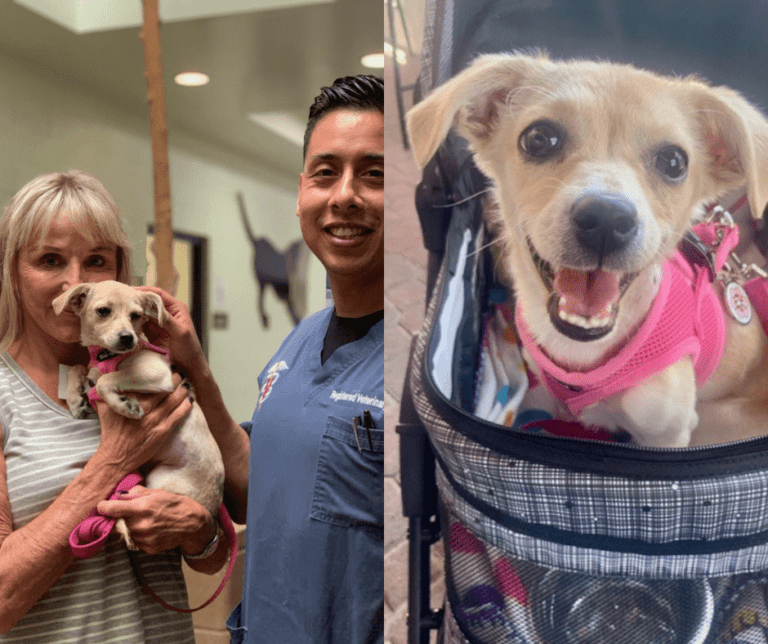Disaster Prep Your Pet: 8 Essentials

If faced with a national disaster, do you have a pet disaster plan? Earthquakes, tornadoes, hurricanes, wildfires and floods happen around the world every day and affect thousands of people and their pets. That’s why everyone should have a plan, not only for yourself, but for your pets. To help you plan for the unthinkable, here are our 9 essentials of disaster prepping for your pet.
- Proper ID. The most important thing you can do for your pet before a disaster occurs is to make sure they have proper ID. This means having a physical tag containing your current info on their collar which they wear at all times, and having them microchipped and registered in a national registry.
- Vaccinations. Keep your pet’s vaccinations up to date to reduce their risk of sickness and disease. There are so many unknowns in a disaster. If you are evacuated, your pet may not be able to come with you to shelter and may be held in boarding with other animals whose health status is unknown. If your home is destroyed, your pet may be lost and living outside for a time and subjected to the elements, dirty water supply or worse. Be safe, not sorry, and vaccinate.
- Display a Pet Rescue Sticker. Make sure you have a pet rescue window decal in a place visible to rescue workers.
- Identify Pet-Friendly Emergency Shelters. Not all emergency shelters or hotels allow pets. Before a disaster hits, call your local emergency management office or animal shelter to see if there are places planned for people and pets to stay together in the event of an emergency. Research pet-friendly hotels away from typical disaster zones, or arrange to stay with family or friends outside of your area. Prepare a few options in a range of distances from your home in case of either local or region-wide emergencies.
- Assemble a Pet Emergency Kit. You can buy a compact kit that fits under your seat, a larger bag you can carry on your shoulder, a grab and go bucket with everything your pet could need or and add pet-related items to your family’s existing emergency supplies. Your kit should include the following items:
- Food and Water
Plan to have at least five days of food, water and portable bowls. Dry food should be in re-sealable plastic bags. If your pet eats wet food, make sure to buy easy open cans so you don’t need a can opener. Prepare a written feeding schedule.
- Medication and Medical Records
Keep an extra supply of your pet’s regular medication in a waterproof zip lock bag. Also include a copy of your pet’s vaccination record and microchip number.
- Supplies
For cats, include kitty litter and disposable litter boxes. For dogs, pack plastic waste bags and an extra leash and harness. Beds, blankets, toys and clothing are also useful to keep your pet calm and cozy in an emergency situation.
- Store Supplies for a Speedy Exit. Place all of your emergency supplies in a safe, dry, convenient place near your escape route in case you need to leave in a hurry. The safest way to transport a pet in an emergency or disaster is in a carrier or crate, so keep one close to your emergency kit. Frightened pets can be difficult to manage with only a leash and collar.
- When a Disaster Strikes, Don’t Hesitate; Evacuate. Not all disasters come with warning, but if they do, follow emergency response recommendations and evacuate as quickly as possible. Disasters are very stressful on both pets and people, and no one can predict how bad things will get. Don’t wait until the last minute to leave. Use your emergency plan as a tool to supplement first responder instructions.
- Leave with your Pets. If the area is not safe for you, it’s not safe for your pets. It may not be possible to return for your pets, so take them with you from the start.
For more information about Pet Disaster Preparedness, please visit the following websites:
- Preparing your Pets for Emergencies, Federal Emergency Management Agency (FEMA)
- Make a Disaster Plan for Pets, Humane Society United States (HSUS)
- Disaster Preparedness, ASPCA
- Pets and Disaster Checklist, American Red Cross
- Saving the Whole Family Brochure, American Veterinary Medical Association
The Michelson Found Animals Foundation’s mission of saving pets and enriching lives is made possible by the generous contributions of Dr. Gary Michelson and Alya Michelson.


